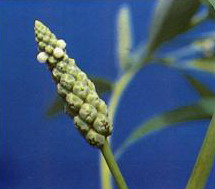Sphenoclea zeylanica

Latin name
Sphenoclea zeylanica Gaertner
Family
Sphenocleaceae
Common name
Gooseweed
Synonyms
Gaertnera pongati Retz., Pongatium indicum Lam., P. zeylanicum (Gaertner) Kuntze, P. spongiosum Blanco, Rapinia herbacea Lour., Reichelia palustris Blanco
Geographical distribution
South and Southeast Asia: Bangladesh, Cambodia, India, Indonesia, Lao PDR, Malaysia Myanmar, Nepal, Pakistan, Philippines, Sri Lanka, Thailand, and Vietnam.
Rest of the world: Bolivia, Colombia, Costa Rica, Ecuador, Iran, Madagascar, Nicaragua, Nigeria, Paraguay, Peru, Senegal, Solomon Islands, Surinam, Tanzania, United States, Venezuela, and Zambia.

Morphology
An erect, branched herb, 7−150 cm tall.
Leaf: simple and spirally arranged light green; blades oblong to lance-shaped, narrowed at the tip, 10 cm long, borne on short stalks.
Inflorescence: green, cylindrical, 7.5 cm long and dense terminal spike; flowers densely crowded, white to greenish, sessile.
Fruit: a flat, 4−5 mm diameter globular capsule.
Seed: yellowish brown, 0.5 mm long.
Agricultural importance
Reported to cause yield loss of 25−50% in rice. Young plants and tips of older plants are steamed and eaten as a vegetable in Indonesia.
Management
Cultural control: closed crop canopy limits germination and growth of the weed.
Chemical control: Anilofos, bensulfuron, cinosulfuron, chlorimuron, metsulfuron, prazosulfuron, thiobencarb, oxadiazon, piperophos, and propanil are reported to be effective.
Selected references
- Airy Shaw HK. 948. Sphenocleaceae. Flora Malesiana Ser. 1 Vol 4:27-28.
- Holm LG, Plucknett DL, Pancho JV, Herberger JP. 1977. The world's worst weeds: distribution and biology. Honolulu, Hawaii (USA): The University Press of Hawaii. 609 p.
- Kenji Noda, Teerawatsakul M, Prakongvongs C, Chaiwiratnukul L. 1985. Major weeds in Thailand. Bangkok (Thailand): Department of Agriculture. National Weed Science Research Institute Project. 142 p.
- Merrill ED. 1976. A flora of Manila. Manila (Philippines): Department of the Interior, Bureau of Science. 491 p.
- Moody K. 1989. Weeds reported in South and Southeast Asia. Manila (Philippines): International Rice Research Institute. 442 p.
- Moody K, Munroe CE, Lubigan RT, Paller Jr. EC. 1984. Major weeds of the Philippines. College, Laguna (Philippines): Weed Science Society of the Philippines, University of the Philippines at Los Baños. 328 p.
- Pancho JV, Obien SR. 1995. Manual of ricefield weeds in the Philippines. Muñoz, Nueva Ecija (Philippines): Philippine Rice Research Institute. 543 p.
- Soerjani M, Kostermans AJGH, Tjitrosoepomo G. 1987. Weeds of rice in Indonesia. Jakarta (Indonesia): Balai Pustaka. 716 p.







